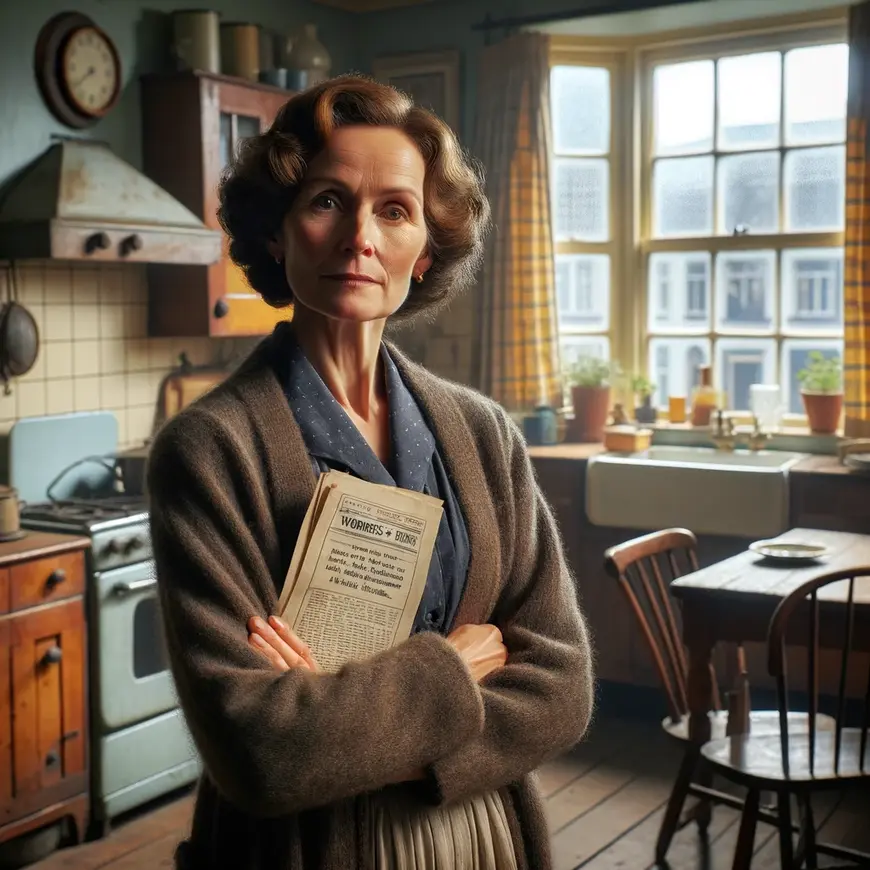“The Mother” by Bertolt Brecht: A Compelling Dive into the Struggles of Working-Class Women
“The Mother,” a powerful play penned by German writer Bertolt Brecht, is a thought-provoking piece of theater that delves into the life of a working-class woman during a time of political upheaval and social change. Brecht’s distinctive style of epic theater, which seeks to engage and challenge the audience, shines through this play. In this review, we will explore the key elements of “The Mother,” including its plot, characters, themes, and the impact it has on the audience. This compelling work of art invites us to reflect on the complexities of the human condition and the role of women in society, making it an enduring and relevant piece of theater.

Plot Summary: A Dive into “The Mother” by Bertolt Brecht
“The Mother” is set in a Russian industrial town in the early 20th century, amidst the backdrop of political unrest and labor strikes. The story revolves around Pelagea Vlassova, the titular mother, whose life is intricately woven with the struggles of the working class. As the play unfolds, we witness Pelagea’s transformation from a submissive, traditional wife and mother to a resolute and empowered woman who actively participates in the revolutionary movement.
The play begins with Pelagea’s husband, Pavel Vlassov, getting involved in the workers’ protest against harsh labor conditions. This involvement eventually leads to his imprisonment, leaving Pelagea to fend for her children and grapple with the harsh realities of life in a society divided by class and ideology.
Pelagea’s journey is marked by a series of events that challenge her world view. She becomes involved in the revolutionary movement, which initially is motivated by the desire to secure her husband’s release. However, as the story unfolds, we witness her ideological transformation. She evolves from a hesitant participant to a passionate advocate for the workers’ cause, willing to risk her own safety for the greater good.
The play reaches its climax when Pelagea confronts the oppressive factory owner, Lopakhin, with a passionate and moving speech that underscores her transformation. This pivotal moment encapsulates the essence of the play, highlighting the power of individual agency in the face of injustice.
The story of “The Mother” offers a compelling narrative, filled with dramatic tension, emotional depth, and social commentary. It’s a journey of self-discovery and empowerment that resonates with audiences even today.
Characters and Their Significance in “The Mother” by Bertolt Brecht
The characters in “The Mother” are multi-dimensional and contribute to the play’s exploration of class struggle, gender roles, and individual transformation. Let’s take a closer look at some of the key characters:
- Pelagea Vlassova (The Mother): Pelagea is the central character of the play. Her journey from a submissive housewife to an empowered advocate for the working class is the heart of the story. Pelagea’s character highlights the potential for change and resistance even in the most unexpected individuals. Her transformation is a powerful testament to the strength of the human spirit.
- Pavel Vlassov (The Father): Pavel is Pelagea’s husband and an important catalyst for the events in the play. His initial involvement in the labor movement leads to his imprisonment, setting the stage for Pelagea’s transformation. Pavel’s character represents the traditional male role in the family and society, which is challenged by the changing tides of revolution.
- Lopakhin (The Factory Owner): Lopakhin embodies the exploitative factory owner who profits from the labor of the working class. He serves as a stark contrast to the suffering of the workers and the ideals of the revolution. Lopakhin’s character illustrates the class divisions and the capitalist system that the revolution seeks to overthrow.
- Vassilisa (Vasya): Vassilisa is Pelagea and Pavel’s daughter. Her character reflects the impact of their parents’ political involvement on the younger generation. Vasya’s transformation from a sheltered child to an aware and politically engaged young woman is emblematic of the broader societal changes taking place.
- Matvey and Bazarov: These two workers play a significant role in the narrative as they influence Pelagea’s political awakening. They represent the voices of the working class and the catalysts for change within the story.
The characters in “The Mother” are not one-dimensional; they undergo significant development throughout the play, mirroring the societal changes occurring in early 20th-century Russia. Brecht skillfully uses these characters to draw the audience into the complex interplay of social, political, and personal forces at work.

Themes and Social Commentary
“The Mother” is rich with themes and social commentary, making it a thought-provoking piece of theater that continues to resonate with contemporary audiences.
- Class Struggle: One of the central themes in the play is the struggle of the working class against oppressive conditions. Through the characters and their experiences, Brecht vividly portrays the hardships faced by the laborers and their fight for better working conditions, fair wages, and basic rights. The play underscores the systemic inequalities inherent in a capitalist society.
- Empowerment: The theme of empowerment is exemplified in the character of Pelagea. Her transformation from a submissive housewife to a revolutionary activist symbolizes the potential for individuals to find their voice and take a stand against injustice. Pelagea’s journey is a testament to the idea that even those initially reluctant to engage in political movements can become powerful advocates for change.
- Gender Roles: “The Mother” also explores the limitations imposed on women in a patriarchal society. Pelagea initially adheres to traditional gender roles but defies these expectations as she becomes a key figure in the revolutionary movement. The play challenges the idea that women are passive participants in political and social change.
- Revolution and Ideology: The broader context of the Russian Revolution serves as the backdrop for the play. “The Mother” raises questions about the role of ideology in motivating individuals to take action. It portrays how personal struggles and political ideals intersect and influence each other.
- The Human Spirit: At its core, the play is about the resilience of the human spirit in the face of adversity. It emphasizes the capacity of individuals to change, grow, and adapt to the shifting dynamics of their environment. Pelagea’s transformation stands as a symbol of hope and determination in the midst of turmoil.
Brecht’s use of these themes not only engages the audience but also encourages reflection on the broader social and political issues that persist to this day.
Brecht’s Distinctive Style: Epic Theater
Brecht is renowned for his unique style of theater, often referred to as “epic theater.” This approach seeks to distance the audience from the characters and plot, allowing them to engage in critical thinking and analysis. “The Mother” exemplifies several key elements of Brecht’s epic theater:
- Verfremdungseffekt (The Alienation Effect): Brecht wanted to prevent the audience from getting too emotionally involved with the characters. He believed that emotional engagement could limit critical thinking. In “The Mother,” this effect is achieved through techniques such as characters breaking the fourth wall, using placards to explain scenes, and employing stark and symbolic staging.
- Didacticism: Epic theater aims to educate and provoke the audience. Brecht uses the play as a platform for political and social commentary, urging the audience to think critically about the issues presented. “The Mother” is not just a play; it’s a political statement.
- Non-linear Narrative: Brecht often employed non-linear storytelling to disrupt the traditional flow of a play. “The Mother” uses flashbacks and fragmented scenes to keep the audience on their toes, preventing them from becoming too absorbed in the story.
- Collective Experience: Epic theater encourages the audience to view the play as a collective experience, rather than a passive one. The use of placards and other techniques reminds the audience that they are part of a larger conversation about societal issues.
Brecht’s innovative approach challenges the traditional conventions of theater and invites the audience to think critically about the themes and messages presented in “The Mother.”

Impact on the Audience
“The Mother” is not a play that leaves its audience indifferent. It sparks discussions, introspection, and emotional engagement. Here’s how it impacts the audience:
- Critical Thinking: Brecht’s epic theater style encourages the audience to think critically about the play’s themes and messages. It prompts viewers to question the social and political dynamics at play and how they relate to their own lives.
- Emotional Engagement: While epic theater aims to distance the audience emotionally, “The Mother” has the opposite effect. Pelagea’s transformation and the struggles of the working class elicit powerful emotions, making the audience deeply empathetic to the characters’ plights.
- Dialogue and Debate: “The Mother” often serves as a conversation starter. After watching the play, audiences are likely to engage in discussions about the themes, characters, and the broader societal issues raised by the play. It has the potential to ignite meaningful debates on topics like class struggle, gender roles, and empowerment.
- Inspiration for Change: Pelagea’s transformation from a meek housewife to a determined activist can serve as an inspiration for those who watch the play. It reminds the audience of the potential for individual agency and personal growth, encouraging them to stand up against injustice.
“The Mother” is not a passive experience; it challenges, provokes, and lingers in the minds of its viewers long after the final curtain falls.
5 Famous Quotes from “The Mother” by Bertolt Brecht
- “We need a school where we can learn to read and write, but also to understand what’s happening around us.”
- Explanation: This quote underscores the importance of education not just in basic literacy, but in political and social awareness. Brecht emphasizes that understanding and interpreting the socio-political environment is crucial for empowerment and activism.
- “You can’t learn to fight, to resist oppression, just by studying. You need to struggle, to act.”
- Explanation: Brecht highlights the necessity of practical experience in activism. Theoretical knowledge alone is insufficient; real change comes from direct action and involvement in the struggle against oppression.
- “If we don’t learn to work together, we will be defeated together.”
- Explanation: This quote reflects the theme of solidarity and collective action. Brecht is advocating for unity among the oppressed classes, suggesting that cooperation is essential for successful resistance against those in power.
- “The food they eat is taken from us, and we do nothing.”
- Explanation: This statement points to the exploitation of the working class by the ruling class. Brecht uses this quote to illustrate the injustice of the economic system, where the labor of the workers benefits the wealthy, and emphasizes the need for awareness and action to reclaim what is rightfully theirs.
- “It’s no use complaining about the dark if you don’t light a candle.”
- Explanation: Brecht uses this metaphor to encourage proactive behavior. Instead of merely lamenting their situation, individuals must take initiative and do something to change it. The quote inspires a sense of responsibility and action in the face of adversity.
Trivia Facts about “The Mother” by Bertolt Brecht
- Adaptation of Maxim Gorky’s Novel: “The Mother” by Bertolt Brecht is an adaptation of the novel “The Mother” by Russian writer Maxim Gorky. Gorky’s novel, published in 1906, is a seminal work in socialist literature and greatly influenced Brecht. Both works focus on the transformation of a working-class woman into a revolutionary, emphasizing themes of social justice and class struggle.
- Berlin’s Theatrical Scene: “The Mother” was first performed in Berlin in 1932. Berlin, during the Weimar Republic, was a vibrant center for theater and the arts, and Brecht was at the heart of its avant-garde scene. The city’s dynamic cultural environment fostered experimental and political theater, providing the perfect backdrop for Brecht’s works, including “The Mother.”
- Collaboration with Hanns Eisler: The music for “The Mother” was composed by Hanns Eisler, a close collaborator of Brecht. Eisler was an influential composer and a student of Arnold Schoenberg. His collaboration with Brecht on numerous works, including “The Mother,” combined powerful music with Brecht’s revolutionary themes, enhancing the emotional and political impact of the plays.
- Exile and Influence: Brecht’s adaptation of “The Mother” was influenced by his experiences in exile. After fleeing Nazi Germany in 1933, Brecht lived in various cities including Prague, Vienna, Zurich, and finally settled in the United States. These experiences exposed him to different political climates and artistic communities, shaping his development of epic theater and his emphasis on using theater as a tool for social change.
- Connection to the Moscow Art Theatre: Brecht’s work, including “The Mother,” was influenced by the Moscow Art Theatre, founded by Konstantin Stanislavski and Vladimir Nemirovich-Danchenko. While Brecht’s approach to theater diverged from Stanislavski’s method acting, he was inspired by the Moscow Art Theatre’s commitment to realism and its focus on social issues. This influence is evident in Brecht’s use of realism combined with his epic theater techniques to engage audiences intellectually and politically.
Conclusion “The Mother” by Bertolt Brecht
“The Mother” by Bertolt Brecht is a timeless work of theater that captivates its audience through a powerful narrative, well-developed characters, and thought-provoking themes. Brecht’s distinctive style of epic theater adds a layer of depth to the play, inviting the audience to engage critically with the story and the societal issues it presents. Through the character of Pelagea, “The Mother” explores the transformative potential of the human spirit, the challenges of gender roles, and the struggle of the working class in a capitalist society.
While set in the context of the Russian Revolution, the play’s themes and messages remain relevant today. It serves as a reminder of the enduring struggle for social justice, empowerment, and the power of the individual to effect change. “The Mother” is not just a play; it’s a call to action, a catalyst for dialogue, and a testament to the indomitable spirit of the human experience. Brecht’s work continues to resonate with audiences, encouraging them to question, reflect, and engage with the world around them, just as he intended.
Other Reviews of Works by Bertolt Brecht
The Morality on Life’s Stage – A Review of “The Good Person of Szechwan” by Bertolt Brecht In the realm…
The Dark and Complex World of “Baal” by Bertolt Brecht “Baal,” a play written by the renowned German playwright Bertolt…
The Threepenny Opera by Bertolt Brecht: A Masterpiece of Social Satire and Musical Brilliance Step into the gritty and thrilling…
Illuminating the Mind – “A Life of Galileo” by Bertolt Brecht Bertolt Brecht, the visionary German playwright, shines a spotlight…
Mother Courage and Her Children
A Powerful Tale of Resilience and Sacrifice: Bertolt Brecht’s “Mother Courage and Her Children” Bertolt Brecht, the influential German playwright,…




